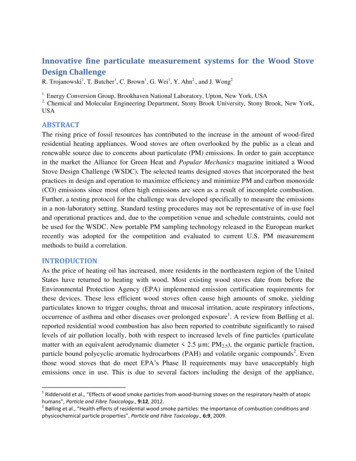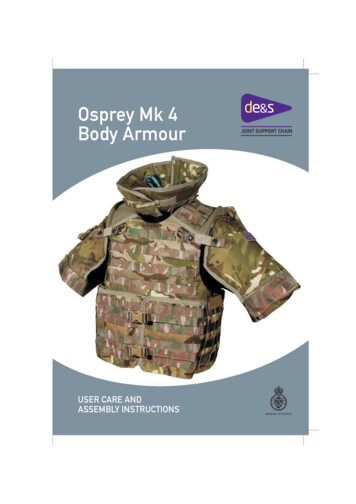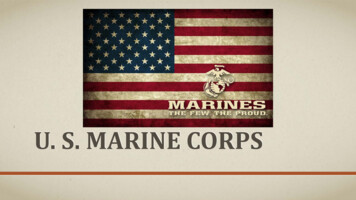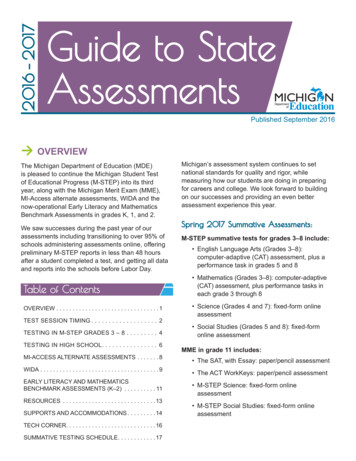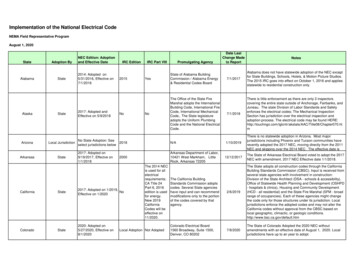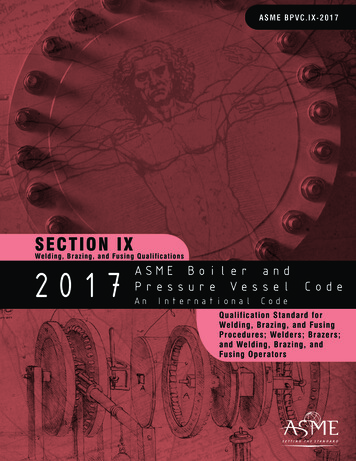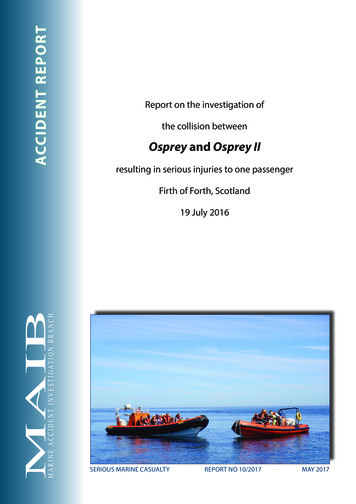
Transcription
ACCIDENT REPORTReport on the investigation ofthe collision betweenOsprey and Osprey IIresulting in serious injuries to one passengerFirth of Forth, ScotlandM A R I N E A C C I D E N T I N V E S T I G AT I O N B R A N C H19 July 2016SERIOUS MARINE CASUALTYREPORT NO 10/2017MAY 2017
Extract fromThe United Kingdom Merchant Shipping(Accident Reporting and Investigation)Regulations 2012 – Regulation 5:“The sole objective of the investigation of an accident under the Merchant Shipping (AccidentReporting and Investigation) Regulations 2012 shall be the prevention of future accidentsthrough the ascertainment of its causes and circumstances. It shall not be the purpose of aninvestigation to determine liability nor, except so far as is necessary to achieve its objective,to apportion blame.”NOTEThis report is not written with litigation in mind and, pursuant to Regulation 14(14) of theMerchant Shipping (Accident Reporting and Investigation) Regulations 2012, shall beinadmissible in any judicial proceedings whose purpose, or one of whose purposes is toattribute or apportion liability or blame. Crown copyright, 2017You may re-use this document/publication (not including departmental or agency logos) free ofcharge in any format or medium. You must re-use it accurately and not in a misleading context.The material must be acknowledged as Crown copyright and you must give the title of the sourcepublication. Where we have identified any third party copyright material you will need to obtainpermission from the copyright holders concerned.All MAIB publications can be found on our website: www.gov.uk/maibFor all enquiries:Marine Accident Investigation BranchSpring Place105 Commercial RoadSouthamptonUnited KingdomSO15 1GHPress enquiries during office hours: 01932 440015Press enquiries out of hours: 020 7944 4292Email:maib@dft.gsi.gov.ukTelephone: 44 (0) 23 8039 5500Fax: 44 (0) 23 8023 2459
CONTENTSGLOSSARY OF ABBREVIATIONS, ACRONYMS AND TERMSSYNOPSIS1SECTION 1 - FACTUAL INFORMATION21.11.21.3Particulars of Osprey, Osprey II and accidentBackgroundNarrative1.3.1 Events prior to departure1.3.2 Departure from Anstruther1.3.3 The collision1.3.4 Post-collision events1.4 Isle of May Boat Trips Ltd1.4.1General1.4.2 Twin RIB operation1.4.3 Passenger spaces1.4.4 Safety management1.5 Vessels' details – Osprey and Osprey II1.5.1 Particulars1.5.2 The skippers1.6 Damage to the RIBS1.7 Injuries sustained1.8 Small Commercial Vessel Code1.8.1 Background1.8.2 Seating arrangements1.8.3 Passenger numbers1.8.4 Risk assessment1.9 Published guidance for RIB operations1.9.1Passenger Safety on Small Commercial High Speed Craft1.9.2 Small Passenger Craft High Speed Experience Rides1.9.3 Shocks and Impacts on Small Vessels1.10 Port authorities1.11 Recreational Craft Directive1.12 Previous/similar 1717181819SECTION 2 - cident overviewThe power turn manoeuvreSeating arrangementsCurrent regulation and guidanceUse of kill cordCare of the injured passengerSECTION 3 - CONCLUSIONS3.1Safety issues directly contributing to the accident that have been addressed orresulted in recommendations2727
3.2 Safety issues not directly contributing to the accident that have been addressedor resulted in recommendations3.3 Other safety issues not directly contributing to the accident2727SECTION 4 - ACTION TAKEN294.1 MAIB actions4.2 Actions taken by other organisations2929SECTION 5 - RECOMMENDATIONS30
FIGURESFigure 1-Chart showing Anstruther Harbour and Isle of May with accidentlocation highlightedFigure 2-Osprey II passengers, shortly after departing Anstruther, showing twopassengers and the skipper’s son seated on the tubesFigure 3-Both RIBs approaching the stern of May PrincessFigure 4-Both RIBs commencing power turnFigure 5-Osprey about to collide with Osprey IIFigure 6-Injured passenger in slumped position following collisionFigure 7-OspreyFigure 8-Osprey II (inset showing actual seating position of the injuredpassenger)Figure 9-Damage to gel coat on Osprey’s bowFigure 10-Damage to Osprey IIFigure 11-Power turn manoeuvreFigure 12-Examples of inappropriate seating on RIBs operating around the UK-MAIB flyer to the small commercial vessel industryANNEXESAnnex A
GLOSSARY OF ABBREVIATIONS, ACRONYMS AND TERMSCA-Certifying AuthorityGRP-Glass reinforced plasticKill cord-A device for stopping a boat’s engine if the driver moves away fromthe controlsKnots-A measure of speed in nautical miles per hourMCA-Maritime and Coastguard AgencyMGN-Marine Guidance NotePBA-Passenger Boat AssociationPLA-Port of London AuthorityRCD-Recreational Craft DirectiveRIB-Rigid Inflatable BoatRYA-Royal Yachting AssociationSCV-Small Commercial VesselUTC-Universal Co-ordinated TimeVHF-Very high frequencyTIMES: all times used in this report are local (UTC 1) unless otherwise stated
SYNOPSISAt 1252 on 19 July 2016, two passenger carrying rigid inflatable boats, Osprey and OspreyII, collided in the Firth of Forth. A passenger who was sitting on an inflatable tube of OspreyII was crushed between Osprey’s bow and Osprey II’s helm console, resulting in hersustaining serious injuries.Both RIBs had departed from Anstruther Harbour and were bound for the Isle of May. Whileproceeding in parallel at a speed of around 6 knots, the skipper of each RIB increasedspeed and commenced a power turn away from each other with the intention of passingeach other in the course of completing a round turn. However, as the RIBs turned towardseach other, it became apparent to both skippers that the RIBs were in danger of colliding.Although they both acted quickly to reduce the speed of their respective vessels and solessen the impact, they were unable to prevent the collision.The manoeuvre had previously been carried out successfully on several occasions butit had not been formally risk assessed and no thought had been given to what to do if acollision situation developed.There are currently no regulations preventing persons on RIBs from sitting on the inflatabletubes. However, passengers not sitting on suitable inboard seating have an increased riskof falling overboard, are at significant risk of musculoskeletal injuries and, as identified inthis accident, are more likely to be seriously injured in the event of a collision.The operating company, Isle of May Boat Trips Ltd, has since banned similar manoeuvresin future and has prohibited crew and passengers from sitting on the RIB inflatable tubes.A recommendation has been made to the Maritime and Coastguard Agency to include inits forthcoming Recreational Craft Code requirements for suitable seating in respect ofcommercially operated passenger carrying RIBs.1
SECTION 1 - FACTUAL INFORMATION1.1PARTICULARS OF OSPREY, OSPREY II AND ACCIDENTSHIP PARTICULARSVessel’s nameOspreyOsprey IIFlagUKUKCertifying AuthorityRoyal Yachting AssociationRoyal Yachting AssociationTypeHumber Quinquari RigidInflatable BoatHumber Quinquari RigidInflatable BoatRegistered ownerIsle of May Boat Trips LtdIsle of May Boat Trips LtdManager(s)Isle of May Boat Trips LtdIsle of May Boat Trips LtdConstructionGRP hull with hypaloninflatable tubesGRP hull with hypaloninflatable tubesYear of build20042010Length overall10m8.0mRegistered lengthNot applicableNot applicableGross tonnageNot applicableNot applicableCoded capacity12 passengers 2 crew12 passengers 2 crewAuthorised cargoPassengersPassengersVOYAGE PARTICULARSPort of departureAnstruther HarbourAnstruther HarbourPort of arrivalIsle of May (intended)Anstruther HarbourType of voyagePassenger excursionPassenger excursionCargo informationPassengersPassengersManning13 (skipper 12passengers)12 (skipper 11passengers)MARINE CASUALTY INFORMATION2Date and time19 July 2016, 1252Type of marinecasualty or incidentSerious Marine CasualtyLocation of incidentFirth of Forth, ScotlandPlace on boardNot applicableInjuries/fatalitiesNoneSerious injuries to onepassenger
MARINE CASUALTY INFORMATIONDamage/environmentalimpactDamage to GRP on bowof boat/noneOne section of tubepunctured, minor structuraldamage/noneShip operationOn passageOn passageVoyage segmentMid-waterMid-waterExternal & internalenvironmentWind: light airs. Sea State: slight. Visibility: good.Persons on board1312Osprey and Osprey II3
1.2BACKGROUNDIsle of May Boat Trips Ltd owned and operated two rigid inflatable boats (RIBs),Osprey and Osprey II, from Anstruther Harbour, Firth of Forth, Scotland. Thecompany offered passenger trips from April to September to the Isle of May (Figure1), a small island in the outer Firth of Forth. The island is a haven for sea birds andhas a large puffin colony. It was a popular destination for tourists and Osprey waspermitted to land 12 passengers daily.The company, which was owned by Osprey’s skipper, advertised three different RIBtours: ‘‘May Experience’ – a trip to the Isle of May with passengers disembarkingonto the island for several hours before returning to Anstruther. ‘Taste of May’ – a trip around the Isle of May, not landing on the Island andreturning to Anstruther. ‘Coastal Dash’ – a joyride along the coast to enjoy the thrill of the boat rideand experience coastline from the sea.’ [sic]Isle of May Boat Trips Ltd operated in partnership, and shared offices, withAnstruther Pleasure Cruises Limited, which operated the Isle of May ferry, MayPrincess. May Princess carried up to 100 passengers from Anstruther Harbour tothe Isle of May each day from April to September.A scheduled departure timetable was published in advance. As Anstruther Harbourwas tidal, departure times varied depending on the tide. Osprey operated everyday throughout the season, Osprey II did not operate on Tuesdays, Wednesdays orFridays.1.3NARRATIVE1.3.1 Events prior to departureOn Tuesday 19 July 2016, Osprey was fully booked with 12 passengers for itsscheduled 1230 ‘May Experience’ tour departure. Fine weather was forecast andseveral other potential customers had expressed an interest in a trip. Osprey II wasnot scheduled to operate that day but, owing to the fine weather and high passengerdemand, the decision was taken to run a ‘Taste of May’ tour.At 0800, Osprey’s skipper contacted Osprey II’s skipper, who confirmed he wasavailable to run the additional tour provided he could bring his 8-year old son withhim. This was agreed, and throughout the morning 10 Osprey II spaces were sold topassengers for a 1230 departure time.At 0930, Osprey’s skipper arrived at Anstruther Harbour with fuel in jerry cans forboth RIBs. He then opened the booking office, and began to process bookings andpaperwork for the day’s trips. Soon after, Osprey II’s skipper arrived, accompaniedby his son. Both RIBs were fuelled and then Osprey II was moved from its berth inthe marina to the passenger boarding embarkation steps.4
5Scale1 mileFigure 1: Chart showing Anstruther Harbour and Isle of May with accident location highlightedApproximate location of accidentAnstruther HarbourReproduced from Admiralty Chart BA 0734 by permission of the Controller of HMSO and the UK Hydrographic Office.Isle of May
At 1215, the skippers distributed and fitted lifejackets to both Osprey and Osprey II’spassengers on the quayside. There were 12 passengers for Osprey, 11 adults and 1child, and 11 passengers for Osprey II, 7 adults and 4 children, 1 being the skipper’sson.A safety briefing was given to all of the passengers by Osprey’s skipper. Eachskipper then led his respective passengers to the boarding area and assisted withtheir boarding. Osprey’s passengers sat on bench seats configured in five rows.Eight of Osprey II’s passengers sat on bench seats configured in four rows, twopassengers each sat in a position on an inflatable tube indicated to them by theskipper, one on each side. On Osprey II the skipper’s son sat on the starboardinflatable tube, in a position aft of the helm console.At 1225 May Princess sailed from Anstruther Harbour, bound for the Isle of May.1.3.2 Departure from AnstrutherAt 1236, Osprey II departed Anstruther Harbour and was joined shortly afterwardsby Osprey. Both vessels then stopped briefly to allow photographs to be taken(Figure 2).Both skippers then increased speed and proceeded towards May Princess, whichwas now 2.5 miles ahead of them. May Princess was travelling at around 6 knots.Osprey II ran parallel with and on the port side of Osprey at an estimated speed of17 knots.Osprey II then crossed behind and onto Osprey’s starboard side, a manoeuvrethat resulted in the passenger sitting on Osprey II’s starboard inflatable tube beingsplashed.As the RIBs approached May Princess’s stern, they slowed down to match its speed(Figure 3).1.3.3 The collisionAt 1251, both skippers glanced at each other and nodded. This was thepre-determined signal to start a turn manoeuvre. Osprey’s skipper increased speedand put his helm hard to port, commencing a power turn to port. Osprey II’s skipperincreased speed and put his helm to starboard, commencing a power turn tostarboard (Figure 4).As the RIBs turned towards each other, it became apparent to both skippers that theRIBs were in danger of colliding. Osprey II’s skipper tried to avoid collision by turningto port, reducing engine speed and engaging astern gear as soon as the enginewould allow. As the RIB rapidly slowed down, a child who was sitting on one of thebench seats slid off her seat and onto the floor. Osprey’s skipper also tried to avoidcollision by turning to starboard and then to port and by engaging astern gear onboth engines, which rapidly slowed the RIB (Figure 5).At 1252, the passenger sitting on Osprey II’s starboard inflatable tube turned awayfrom Osprey’s approaching bow, which then pinned her to Osprey II’s helm console.The starboard aft section of Osprey II’s inflatable tube was punctured and rapidlydeflated.6
Figure 2: Osprey II passengers shortly after departing Anstruther,showing two passengers and the skipper’s son seated on the tubesOsprey II’s skipper, realising that the passenger was injured, pushed Osprey’sbow away, freeing her. The skipper then made an initial assessment of the injuredpassenger, who was in obvious pain but able to communicate. He tried to relocateher onto one of the bench seats, but she was in too much pain to move (Figure 6).1.3.4 Post-collision eventsAt 1255, Osprey’s skipper reported the collision to the coastguard on very highfrequency (VHF) radio Channel 16, advising that both RIBs would be returning toAnstruther Harbour with one injured passenger, and requesting the coastguard toarrange for an ambulance to meet them in Anstruther.May Princess initially stopped following the accident, but then resumed passagetowards the Isle of May once it was established that no additional assistance wasrequired.7
Image courtesy of Teresa Wong-HuiOsprey IIOspreyMay PrincessFigure 3: Both RIBs approaching the stern of May PrincessOspreypower turn to portOsprey IIpower turn to starboardMay PrincessFigure 4: Both RIBs commencing power turn8
Image courtesy of Teresa Wong-HuiFigure 5: Osprey about to collide with Osprey IIImage courtesy of Teresa Wong-HuiInjuredpassengerFigure 6: Injured passenger in slumped position following accident9
Osprey and Osprey II returned towards Anstruther Harbour at slow speed as aconsequence of Osprey II’s deflated section of tube and the injured passenger’sdiscomfort.The injured passenger remained in a slumped position, sitting on the tube andleaning on the helm console. Her husband and one other passenger sat on eitherside of her to provide support and comfort during the return passage.At approximately 1320, Osprey II arrived in Anstruther Harbour and was met by acoastguard team. By 1333, paramedics had begun treating the injured passenger,who was subsequently transferred to hospital.1.4ISLE OF MAY BOAT TRIPS LTD1.4.1 GeneralIsle of May Boat Trips Ltd, which was already operating Osprey, was purchasedby the current owner in 2013. A partnership was formed with Anstruther PleasureCruises Limited, which owned and operated May Princess. The company’s primarybusiness was to offer scheduled passenger tours to and around the Isle of Mayduring the summer season.1.4.2 Twin RIB operationOsprey II was purchased by Isle of May Boat Trips Ltd for the 2016 season. Ospreyand Osprey II were scheduled to depart from Anstruther Harbour at the same timeon particular days, and this had provided an opportunity for their skippers to interactwhile following May Princess on passage to the Isle of May. Consequently, theskippers had developed a manoeuvre that was intended to incorporate a level ofexcitement into the trip, and which had been completed successfully on about 20occasions prior to the accident.The manoeuvre involved both RIBs proceeding towards May Princess with OspreyII parallel with and on the port side of Osprey. The RIBs then crossed each other’spath twice before approaching May Princess’s stern and then slowing down tomatch its speed. After nodding to each other, both skippers increased speed andcommenced a power turn away from each other, resulting in the RIBs passing eachother starboard side to starboard side on reciprocal headings.1.4.3 Passenger spacesIsle of May Boat Trips Ltd operated an online booking system. Bookings could alsobe made in person at the harbour office. While 12 passenger spaces were availablefor tours on Osprey (Figure 7), passenger spaces on Osprey II were normallylimited to the eight spaces available on its four bench seats (Figure 8). However, ingood weather, two additional spaces for Osprey II were sold, allowing 10 passengersto be carried, the additional 2 sitting in designated positions on its inflatable tubes.Each of the designated positions on the inflatable tube had a handhold on the tubeon either side of the seating position.10
5 rows of benchseats with handholdsFigure 7: Osprey4 rows of benchseats with handholdsDesignated seatingInjured passenger’s areas on inflatable tubesseating positionFigure 8: Osprey IIFigure 8 inset: actual seatingposition on tube of Osprey II11
On the day of the accident the additional passengers on Osprey II were directed tosit on the tubes in a position aft of the two designated positions. This allowed them ahandhold on the tube, and a handhold on the stainless steel frame around the helmconsole (Figure 8 inset).1.4.4 Safety managementIsle of May Boat Trips Ltd had a safety management plan, which set out its policieson risk assessment and maintenance, and delegated overall authority for the safetyof a vessel and persons on board to the vessel’s skipper.The company neither provided instructions on twin RIB operation nor specified thelimiting weather conditions when allowing passengers to sit on Osprey II’s inflatabletubes.1.5VESSELS' DETAILS – OSPREY AND OSPREY II1.5.1 ParticularsOsprey and Osprey II were Humber Ocean Pro RIBs, with a glass reinforced plastic(GRP) hull and hypalon inflatable tubes, built by Humber Inflatables. Osprey wasbuilt in 2004 and was powered by two Evinrude 175hp E-Tec outboard engines.Osprey II was built in 2010 and was powered by a single Evinrude 200hp E-Tecoutboard engine.The installation of the engines, steering, passenger seats and final fit out wascompleted by Quinquari Marine, Pembrokeshire.There was a standing helm console towards each RIB’s stern. This console housedthe engine monitoring equipment, steering controls, engine throttle, navigationplotter, VHF radio and magnetic compass.On Osprey there were five rows of bench seating forward of the helm consoleproviding seating for 12 passengers. On Osprey II there were four rows of benchseats forward of the helm console providing seating for eight passengers. Therewere also two designated seating positions, with handholds on the inflatable tube oneach side of the RIB.1.5.2 The skippersOsprey’s skipper was 53 years old. He had been a director and shareholder of Isleof May Boat Trips Ltd since 2013, and had worked full-time at Isle of May Boat TripsLtd since retiring from his previous job in 2014. He held a commercially endorsedRoyal Yachting Association (RYA) Yachtmaster Offshore (Power) Certificate ofCompetence and had previously been an RYA powerboat instructor.Osprey II’s skipper was 50 years old and had worked on May Princess as a crewmember since retiring from the Royal Marines. He had been skipper of OspreyII since it had been purchased by Isle of May Boat Trips Ltd prior to the start ofthe 2016 season. He held a commercially endorsed RYA Powerboat AdvancedCertificate.12
Osprey II’s skipper did not have his engine cut-out kill cord attached when the RIBdeparted Anstruther Harbour on the day of the accident.1.6DAMAGE TO THE RIBSOsprey sustained minor damage to the gel coat on its bow (Figure 9).Damage to gel coatFigure 9: OspreyIn addition to Osprey II sustaining a puncture and tear to the aft starboard section ofits inflatable tube, there was damage to the helm console, starboard navigation lightand stainless steel grab rail (Figure 10).1.7INJURIES SUSTAINEDThe injured passenger was 45 years old. She was travelling on Osprey II with herhusband, who was seated on the opposite inflatable tube, and her two children aged8 and 12 years, who were sitting on bench seats. The family were on holiday in thearea.The severity of the passenger’s injuries did not become apparent until she waspassed to the care of the ambulance crew. On arrival at hospital she was put intoan induced coma, and returned home 3 weeks later to continue her recuperation.She had suffered two broken collar bones, five broken ribs, a punctured lung, andlacerations and bruising to her back and torso. The internal injuries she sustained inthe accident also resulted in permanent damage to her sight in both eyes.13
Damaged navigation lightDisplaced handrailPunctured section of tubeFigure 10: Damage to Osprey II1.8SMALL COMMERCIAL VESSEL CODE1.8.1 BackgroundThe Merchant Shipping (Vessels in Commercial Use for Sport or Pleasure)Regulations 1998 apply to UK vessels wherever they may be and other vesselsoperating from UK ports while in UK waters, except pleasure vessels and vesselscarrying more than 12 passengers. Regulation 6 enables alternative standardscontained in the Maritime and Coastguard Agency (MCA) Small Commercial Vessel(SCV) Code to be used to fulfil the requirements of the Regulations. The SCV Code,which is intended to be replaced by a Recreational Craft Code and a WorkboatCode, is annexed to the MCA’s Marine Guidance Note (MGN) 280 (M)1.The MCA delegates its responsibility to examine vessels, issue and signdeclarations and certificates to a number of approved Certifying Authorities (CAs).The RYA was the CA for Osprey and Osprey II, which were each certified to carry12 passengers and 2 crew, allowing operation within 20 miles from a safe haven infavourable weather and in daylight.114MGN 280 – Small vessels in commercial use for sport or pleasure, workboats and pilot boats – alternativeconstruction standards.
1.8.2 Seating arrangementsIn section 22.2 of the SCV Code, dealing with Bulwarks, Guard Rails and Handrails;section 22.2.6 states:‘In an inflatable boat or a rigid inflatable boat, handgrips, toeholds and handrailsshould be provided as necessary to ensure safety of all persons on board duringtransit and worst weather conditions likely to be encountered in the intendedarea of operation.’The SCV Code makes no reference to the number of seats required on a RIB.Section 25.6.3 of the SCV Code states:‘For seagoing pilot boats, individual shock absorbent seating with headrests,footrests and moveable armrests should be provided for all members ofthe crew and the pilots to be carried. Seat belts should be provided for thesafety of seated passengers and crew. For non-seagoing pilot boats, seatingcommensurate with the vessels expected operating conditions, should beprovided for all passengers and crew.’The SCV Code makes no reference to what constitutes suitable seating on a RIBthat is not a dedicated pilot boat.1.8.3 Passenger numbersThe certified number of passengers that are permitted to be carried on a RIB isdetermined by stability requirements as documented in the SCV Code, and not bythe number of available seats.Osprey and Osprey II were both certified for 12 passengers and 2 crew, 12 beingthe maximum number of passengers permitted to be carried on vessels certifiedunder the SCV Code.1.8.4 Risk assessmentSection 2.10.1 of Annex 3 to the SCV Code states:‘The Merchant Shipping and Fishing Vessels (Health and Safety at Work)Regulations 1997 (SI1997/2962) apply wherever ‘workers’ are employed onships. Under these regulations all employers have a duty to ensure the healthand safety of workers and others, so far as is reasonably practicable. To fulfil thisduty, employers are required to carry out “a suitable and sufficient assessmentof the risks of the health and safety of workers arising in the normal course oftheir activities or duties”.Section 2.10.2 states:‘Applying the principles of health and safety requirements to Code Vesselsmeans that the operator or skipper should take a proactive approach to safetyand consider what particular hazards are likely to arise in the context of workactivities on board. They should then take appropriate measures to remove therisks so far as possible ’15
1.9PUBLISHED GUIDANCE FOR RIB OPERATIONS1.9.1 Passenger Safety on Small Commercial High Speed CraftIn response to a growing number of passenger RIB tours, RIB thrill rides and SeaSafari type RIB trips, and an increase in the number of accidents on these trips, theRYA has published guidance entitled ‘Passenger Safety on Small Commercial HighSpeed Craft’ (issued 1 March 2010).The publication contains advice on the importance of passengers using correcthandholds and adopting good posture, and offers advice to skippers and operatorson safety during passage:16‘8.Passenger Boarding and Departure8.2During the boarding process passengers should be allocated to themost appropriate seating.8.3They should be assisted aboard, shown to their seats and advised howto sit, how to prevent vertical shock and how to use the handholds.’‘9.Safety During Passage9.1The guiding principle of ensuring a safe ride is to keep the craft incontact with the water. Launching a boat off a wave, or even the washof another boat, may generate excitement but the forces encounteredon landing can be extreme and can cause serious injury. Thereforeseeking rough conditions to enhance the thrill of the trip shouldbe considered less than best practice. Even in relatively benignconditions, the shock and vibration experienced can be surprisinglyhigh.9.2Even in relatively calm conditions, high speed craft have been shownto experience impacts of 20g perpendicular to the deck, and in excessof 10g parallel to the deck.9.3High speed U and S turns should be carried out gently and at asafe speed. As each vessel will have specific ride characteristics,operators should ensure that their operating procedures clearly statemaximum operating parameters to this effect. Again, it is important toremember that a boat travelling at speed and heeling to 15-20º maybe exciting to the majority of passengers while frightening the lessconfident ones. Maintaining a safe speed and correct trim is critical.What can be considered safe on a calm day may become reckless inless favourable conditions. However, this does not mean that reducingspeed and/or power is always the correct approach to challenging seaconditions.9.5Passengers must be seated in the seats provided. Some smallcommercial vessel certificates allow for passengers to be seated onthe inflatable collar of a RIB, but those passengers may be exposedto an increased risk of back injury due to the rotated posture they willhave to adopt. If passengers are to sit on the inflatable collar, operators
and skippers should be aware of the additional risks and consideradapting their operating procedures, passage plans and itineraries,especially if sea conditions are less than favourable.’1.9.2 Small Passenger Craft High Speed Experience RidesThe Passenger Boat Association (PBA), in conjunction with the RYA, has producedadditional guidance concerning The management of Small Passenger Craft HighSpeed Experience Rides’ (issued March 2010). The following is an extract:‘5. Structural Considerations Seating arrangements should allow passengers to effectively bracethemselves against repeated shock loadings and violent movements of the boat.Bench seats, particularly without lateral support, should be avoided on vesselsoperating in any sea state beyond calm. Jockey seats are generally acceptablewith effective foam cushioning, as are wrap-around stand-in bolsters. If boatoperations are planned to operate in, or actively seek out rough water, the useof suspension seats is recommended along with an appropriate level of lateralsupport Handholds – all seats should have hand-holds located in front of thepassenger allowing them to hold on with both hands, these should be roughlyat chest height and shoulder width apart. Consideration should be given to thepotential loss of firm hand grip during cold conditions.’1.9.3 Shocks and Impacts on Small VesselsIn 2011, following a series of accidents and injuries to passengers on smallvessels at a wide range of speeds, the MCA published MGN 436 (M F) Guidanceon Mitigating Against the Effects of Shocks and Impacts on Small Vessels. Thefollowing are extracts:‘3.Posture3.3An upright posture, with the spine in neutral alignment (natural ‘S’shape) should be maintained whilst facing in the direction of travel, i.e.sitting or standing sideways generally results in the occupant adoptinga twisted spine thus increasing the stress on the spine and increasingthe risk of injury.’‘5.4Pre-departure briefing5.4.1Operators and owners of all vessels should brief those onboard priorto departure on the inherent risk and the correct posture to reduce thelikelihood of injury
Figure 1 - Chart showing Anstruther Harbour and Isle of May with accident location highlighted Figure 2 - Osprey II. . Figure 12 - Examples of inappropriate seating on RIBs operating around the UK ANNEXES . PBA - Passenger Boat Association PLA - Port o


